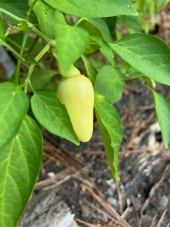For me, it started with a bean.
No ordinary bean, True Red Cranberry is listed on the Slow Food Ark of Taste, and deservedly so. It's truly delicious, as well as prolific. And, this year, unavailable.
I can only infer that there is just a single seedstock grower for it, and they must have had a crop failure last year; despite being listed by several seed vendors, all were out of stock this January. I resigned myself to not growing one of my favorites this year -- and then I found it. A reused plastic container, stashed in the drawer where I carelessly keep leftover seeds, contained three pods, twenty-odd seeds of my prized Cranberry Beans!
"Crisis" averted, but it was a much-needed reality check. I'd been completely dependent on seed companies to ensure my supply. Even as I moved toward more perennials, and installing permaculture gardens/food forests, I had a huge gap in the system (most of my trees and shrubs are a few years out from being really productive). I rarely saved seeds, and I was using varieties developed for a national market, not my specific climate.
Needless to say, I'm changing my ways. My new mindset is to act as if I'll never be able to order seed again. (Not saying that I won't order, just not counting on it.) I'm saving my own seed, and more importantly, selecting strains for my unique growing area. I'm also planning to produce landraces of many crops, so I have the diversity available for making it through wet years, dry years, hot, cold, etc..
I'm assuming I'm late to the party, so I'd love to hear from others about how you are tailoring your seed supplies for long-term survival. What are some best practices that are working for you?











